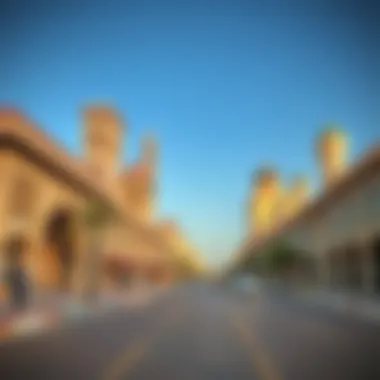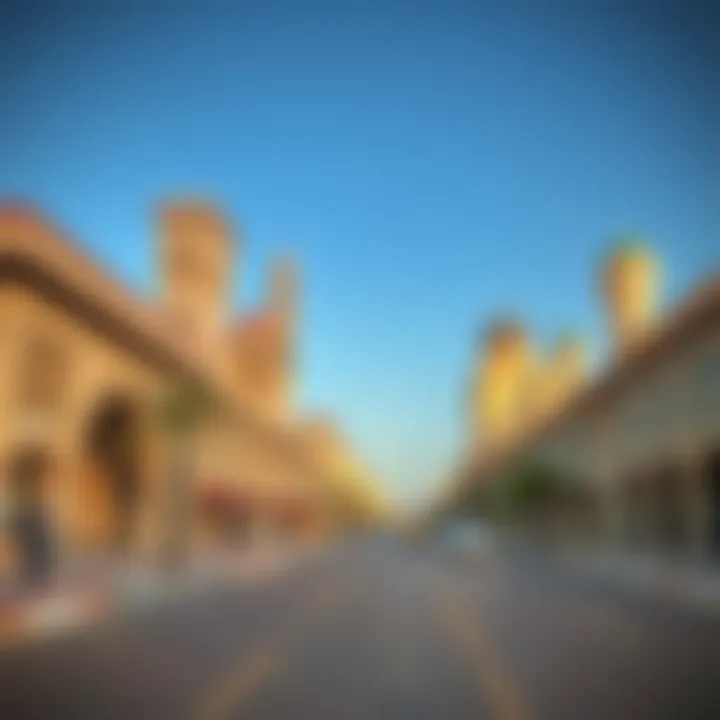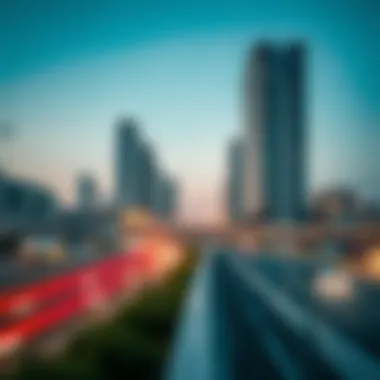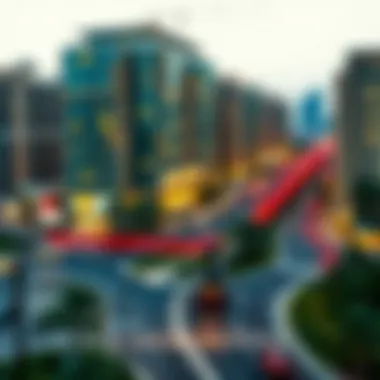Exploring Dubai's Red Line: Insights for Investors


Intro
Dubai's Red Line, running through the heart of this vibrant metropolis, has not only changed the landscape of the city but also influenced its real estate market in profound ways. Stretching from Rashidiya in the northeast to Jebel Ali in the southwest, this rail line has transformed the way residents and investors perceive property values and opportunities in the area.
The importance of the Red Line cannot be overstated. Its inception marked a significant milestone in Dubai's drive towards infrastructural excellence and urban development. As a direct result, various neighborhoods flanking this transit route have witnessed a surge in interest from homebuyers and investors alike.
In this analysis, we delve into several critical components including the historical backdrop, the current state of the market, and the future prospects that individuals engaging with Dubai's real estate sector should consider. The narrative aims to provide a solid understanding of the dynamics at play for everyone from seasoned analysts to first-time homeowners.
Market Trends
Current Real Estate Developments
The Red Line's impact is undeniably visible through the evolution of real estate developments in its vicinity. Projects such as the Dubai Marina and Jumeirah Lakes Towers (JLT) have flourished, offering a mix of luxury apartments and commercial spaces. Many property developers are rushing to capitalize on the strategic location near metro stations, as proximity to public transport generally translates to higher rental yields and property values.
Consider these notable developments:
- The Address Residences Dubai Marina
- Jumeirah Beach Residence (JBR)
- Bluewaters Island
All of these projects cater to a rising demand for high-quality living spaces that residents can access easily via the Red Line. The market is buzzing with activity, as the infrastructural advancements encourage higher foot traffic and, consequently, an influx of businesses looking to set up shop nearby.
Impact of Economic Factors on Real Estate Prices
Economic sentiment and market conditions play a vital role in shaping real estate prices along the Red Line. Recent trends indicate a correlation between Dubai's economic performance and fluctuations in property prices. For instance, lower oil prices and a sluggish global economy could dampen investor confidence, leading to declines in property values.
Despite these challenges, the Dubai government continues to introduce incentives and reforms aimed at attracting foreign investment. The introduction of long-term visas for investors and the easing of regulations can stimulate growth and maintain interest in the Red Line's real estate offerings.
"Even in challenging times, strategic positioning alongside the Red Line offers a unique opportunity for both short and long-term gains."
Investment Strategies
Tips for First-time Buyers
Navigating Dubai's real estate landscape can be daunting, especially for first-time buyers. Here are some wise tips:
- Understand the market: Research neighborhoods and property types within reach of the Red Line.
- Consult professionals: Work with a local real estate agent who possesses intimate knowledge of Dubai’s market.
- Conduct thorough inspections: Ensure the property meets your needs and is structurally sound.
- Plan your finances: Be clear about your budget, factoring in all costs such as maintenance fees, utilities, and taxes.
Long-term vs Short-term Investment Approaches
The choice between long-term and short-term investment strategies can be challenging.
- Long-term investments: These are suitable for individuals looking for stability and gradual appreciation. Properties near the Red Line often see significant value growth over the years.
- Short-term investments: These may appeal to those looking for quick returns through flipping properties. However, this approach carries risks, especially in fluctuating market conditions.
When evaluating investments in the Red Line area, it’s crucial to keep an eye on projected developments and urban planning initiatives as these factors will directly impact property values in the coming years.
For further insights on real estate trends, resources such as Wikipedia and Britannica can provide valuable information.
Overview of Dubai's Red Line
The Red Line of Dubai has become a significant player in the city's complex transport network. This metro line serves as a backbone for both urban mobility and real estate development, linking key areas and drastically transforming the lived experiences of residents and tourists alike. It has not only facilitated easier movement but has also spurred commercial growth and residential investment along its route. Therefore, understanding the Red Line is crucial for anyone interested in the dynamic nature of Dubai’s real estate landscape.
Historical Context
From its inception in 2009, the Red Line has evolved remarkably as part of Dubai’s Vision 2020 initiative, aiming to enhance public transport facilities across the emirate. Initially, this line spanned about 52 kilometers, stretching from Rashidiya in the northeast to Jebel Ali in the southwest.
The motivation behind the line's construction was multifaceted; primarily, it aimed to reduce congestion on roadways, promote eco-friendly transport options, and stand as a showcase of technological advancement. As the city flourished due to tourism and business, the demand for efficient public transportation became ever more pressing. The metro system now serves over 200,000 passengers daily, a testament to its success and importance to Dubai's infrastructure.
Historically, the line reflected Dubai’s rapid growth. What was once a humble desert landscape has transformed into a thriving metropolis; the Red Line helped catalyze this development. Land prices and investment opportunities around the line surged as accessibility improved, further fueling urban expansion. The line's development reveals not just a transportation solution, but a strategy for comprehensive urban growth.
Geographical Scope
The Red Line traverses through several critical districts, effectively connecting various cultural, commercial, and recreational hubs within the city. It runs through areas like Downtown Dubai, known for the iconic Burj Khalifa and the Dubai Mall; these hotspots attract locals and tourists alike, feeding into the area’s economic vitality.
Notably, the areas adjacent to the Red Line have seen a surge in residential developments. For instance, regions such as Dubai Marina and Business Bay host numerous high-rise apartments that cater to a diverse demographic. With its strategic layout, the Red Line runs through key neighborhoods, which amplifies accessibility to essential amenities, making it an attractive choice for both investors and homeowners.


The significance of geographical connectivity can’t be overlooked. With stations strategically placed near major shopping centers, hospitals, and schools, property values are often higher in these areas due to the easy access provided by the Red Line. This enhanced connectivity stimulates both short-term and long-term investment prospects, establishing a desirable living and working environment for all residents.
As the Red Line continues to expand, its potential to reshape Dubai's urban landscape is substantial. Understanding these geographical intricacies is vital for those navigating the ever-evolving real estate market.
"The Red Line is not just a mode of transportation; it’s a catalyst for change within Dubai, shaping how residents interact with the city and explore new opportunities."
The Red Line's Role in Urban Development
The Red Line is not just a transportation network; it serves as a backbone for urban growth in Dubai. This section breaks down how the Red Line interconnects various facets of urban development, from transportation to sustainable initiatives.
Impact on Infrastructure
The Red Line significantly reshapes Dubai’s infrastructure landscape. As city planners have prioritized public transit solutions, the impacts are felt across multiple domains.
Transportation Systems
Transportation systems along the Red Line are pivotal for the consistent movement of both residents and visitors. The Dubai Metro, with its sleek and modern trains, operates on the Red Line, allowing for seamless connectivity. This rapid transit option is a popular choice due to its reliability and efficiency. With its unique feature of being driverless, it minimizes human error and enhances safety.
Furthermore, the integration of the metro with other forms of public transport, such as buses and trams, provides an effective network that reduces traffic congestion. However, despite its numerous advantages, some commuters express concerns about the occasional overcrowding during peak hours, which can detract from the user experience.
Public Amenities
Public amenities around the Red Line act as another layer that enhances urban life. The strategic placement of parks, libraries, and community centers near metro stations promotes a vibrant lifestyle. For instance, the development of Al Rigga Park offers a serene environment amidst the bustling city, thus serving as a key characteristic of these public spaces. Families and individuals often choose these areas for leisure activities, strengthening community ties.
However, maintaining these spaces is a challenge, as the rapid growth of developments can outpace resource allocation, affecting the quality of amenities provided. Nonetheless, the ongoing efforts reflect a commitment to creating inviting environments for everyone.
Residential Areas
Residential areas that align with the Red Line exemplify urban living at its finest. Areas like Dubai Marina and Business Bay provide housing solutions that cater to diverse demographics. The key characteristic of these neighborhoods includes their proximity to public transport, which is invaluable for maintaining a balanced urban lifestyle.
However, the higher price tags on properties near the Red Line can be a deterrent for potential homebuyers looking for affordability. This reality can lead to a balance that needs addressing between luxury and practicality, influencing housing trends in the future.
Sustainable Development Initiatives
Sustainability is threaded through the fabric of development related to the Red Line, positioning Dubai as a forward-thinking metropolis.
Green Spaces
Green spaces are vital in offsetting urban heat and enhancing air quality. The incorporation of parks and vegetation along the Red Line is a step forward in creating a sustainable environment. A notable example is the lush greenery seen in areas such as Downtown Dubai, which not only serves aesthetic purposes but also improves residents’ well-being.
Nevertheless, achieving the right balance of developed land and green areas remains a challenge, especially as demand for land grows.
Smart City Concepts
The Red Line serves as a blueprint for implementing smart city concepts in Dubai. Initiatives like traffic management systems and smart lighting along the transit route are designed to improve energy efficiency and resident safety. These technologies emphasize convenience, making urban living more enjoyable.
However, the challenge lies in keeping up with the pace of innovation. As a rapidly evolving tech landscape presents newer solutions, integrating them smoothly into existing infrastructure can pose hurdles.
The Red Line is more than a transport route; it’s a vital part of Dubai's urban evolution.
In sum, the Red Line embodies a multifaceted approach to urban development, intertwining various aspects that contribute to Dubai’s ambitious urban landscape. From enhancing infrastructure to paving the way for sustainable living, this transportation line is pivotal in shaping the future. As the city continues to evolve, understanding these roles becomes essential for investors and residents alike.
Real Estate Trends Along the Red Line
Understanding real estate trends along Dubai's Red Line is central to grasping the wider dynamics of the city's property landscape. The Red Line acts as a vital artery, facilitating movement and accessibility while driving demographic shifts and investment patterns in the area. Over the past few years, this corridor has seen remarkable growth and transformation, which in turn offers a plethora of options for both investors and homeowners to consider.
Recent Market Analysis
The market trends surrounding the Red Line reflect its rising allure, particularly in the wake of ongoing infrastructural developments and urban enhancement projects. Notably, the area has experienced higher-than-average price appreciation compared to other parts of Dubai. This is largely attributed to the seamless connectivity of the metro line, which not only simplifies commuting but also enhances access to various business districts and cultural hotspots.
A closer look at property demand reveals an increasing interest in both commercial and residential real estates, indicating a healthy balance in investment opportunities. The performance of mid-range to luxury apartments has been particularly noteworthy, showcasing an upward trajectory in rental yields and sales prices.
As of now, average rental rates along the Red Line stand at approximately 10% higher than the overall Dubai market rate, which speaks volumes about the desirability of its location. The rise in foreign investment is another key consideration—many overseas investors find the area to be a focal point for nurturing their portfolios while benefitting from progressive property laws.
Investment Opportunities


Emerging Hotspots
Emerging hotspots along the Red Line represent a promising horizon for prospective investors. Areas such as Dubai Marina and Jumeirah Lake Towers stand out due to their robust infrastructure and burgeoning local economies. These aforementioned spots have unique characteristics—like waterfront destinations, a thriving nightlife, and proximity to business centers—that align well with the interests of millennials and expatriates.
Investors eyeing these neighborhoods will find several advantages in their growth potential. These locations are teetering on the edge of mainstream popularity, with property values remaining comparatively affordable. As new developments unfold and community facilities enhance, the value proposition becomes ever more enticing for those looking to buy low before prices rise.
Luxury Developments
Luxury developments along the Red Line further embody the essence of Dubai's opulence. Properties such as those in Downtown Dubai or the Burj Khalifa area offer lavish amenities and architectural finesse that attract affluent buyers worldwide. The key characteristic of these luxury residential units lies in their premium finishes and unbeatable locations, giving residents the best of what urban living can provide.
However, investing in luxury real estate along the Red Line does come with its challenges. While potential returns can be substantial, the high entry price may deter some investors. Moreover, luxury markets in Dubai can be somewhat volatile—economic fluctuations may shift demand considerably, requiring investors to be astute and patient.
Affordable Housing Options
Affordable housing options present a contrasting yet vital segment of the Red Line's real estate market. Initiatives promoting affordable housing have gained traction among developers, aiming to meet the needs of Dubai's growing workforce and families. Locations such as Al Qusais and Al Rigga are emerging as prominent choices, blending value with accessibility.
The affordability factor appeals to both first-time homebuyers and investors looking to build rental portfolios. The unique feature of these options is their strategic location close to public transport, which significantly reduces commuting costs for residents. However, one should remain cautious—some may argue that affordable housing can suffer from lower-quality constructions in the rush to build quickly.
The balance between price and quality, while often tricky, is crucial when evaluating these opportunities.
"Investors looking towards the Red Line are not just aiming for immediate returns; they are setting their sights on long-term stability in Dubai’s evolving landscape."
In summary, the real estate trends along the Red Line are distinct and compelling, showcasing a diverse mix of options ranging from luxury estates to emerging hotspots and affordable housing. Understanding these dynamics is important for any investor or homeowner considering a stake in this vibrant area.
Commercial Real Estate along the Red Line
The significance of commercial real estate along Dubai's Red Line cannot be overstated. As a lifeline connecting key districts and regions, the Red Line has cultivated a vibrant landscape for businesses looking to establish themselves in a rapidly evolving market. The area is pivotal not only for attracting global investments but also for fostering a diverse and dynamic economic ecosystem that benefits local entrepreneurs and multinational corporations alike.
Business Districts
The Red Line is dotted with various business districts, each with its unique character and appeal. Zones like Dubai Marina and Business Bay offer prime real estate opportunities for companies seeking visibility and accessibility. These districts are strategically placed near major thoroughfares and residential areas, ensuring that employees and clients can easily navigate the bustling city.
In addition to attracting traditional office setups, there's a rise in co-working spaces and tech hubs, particularly around areas like Jumeirah Lakes Towers (JLT). This shift mirrors global trends towards flexibility in workspaces, as businesses adapt to a rapidly changing economy. The influx of tourists and professionals into these districts also supports a robust rental market for office spaces.
Key Features of Business Districts Along the Red Line:
- Accessibility: With the metro providing seamless transit options, employees can commute conveniently.
- Amenities: Business hubs often come equipped with nearby cafes, restaurants, and recreational possibilities, which are crucial for a balanced work-life dynamic.
- Networking Opportunities: The presence of diverse companies facilitates collaborations and networking, benefitting start-ups and established firms alike.
Investment Potential for Businesses
The investment potential for businesses along the Red Line is considerable. The ongoing infrastructural developments and planned projects make this area a hotspot for investors. The Dubai Expo 2020 has heightened interest in this corridor, signaling a wave of potential long-term growth.
Investors are particularly interested in how the metro line's influence can enhance property values. Companies that align their operations near transit stations may experience significant benefits, drawing clients and talent due to increased accessibility. The realization of these potential benefits, however, comes with understanding the local market dynamics. Such considerations encompass:
- Demand for Retail Spaces: As more people flock to the area, retail spaces become prime investments. Businesses can leverage foot traffic generated by the metro stations, leading to better sales and visibility.
- Flexibility in Lease Options: Investors can explore various leasing strategies, catering to both local businesses and international firms. This flexibility makes commercial real estate along the Red Line adaptable to shifting market needs.
- Government Support: Initiatives by local authorities encourage foreign investments and support local startups through favorable policies. This factor enriches the commercial landscape and potentially increases returns on investment.
"Investing in commercial real estate along the Red Line is not just about land; it's about tapping into the heart of Dubai's evolving infrastructure and economy."
As various substations along the Red Line flourish, businesses have an opportunity not just to establish a presence but to thrive within a context that is increasingly supportive of commercial interests. As the landscape shifts, stakeholders should remain vigilant, adapting to the currents of change and innovation in this vibrant urban corridor.
Lifestyle and Community Features
Understanding the lifestyle and community features along the Red Line in Dubai is vital for those looking to invest, live, or simply comprehend the area’s vibrancy. The Red Line isn’t just about transport; it creates a dynamic environment interwoven with cultural attractions and amenities that enhance daily life. Recognizing these elements can significantly shape decisions regarding living and investing in this bustling corridor.
Living Along the Red Line
Cultural Attractions
Cultural attractions along the Red Line play a crucial role in shaping the community’s identity. Locations like the Dubai Opera and the Dubai Museum vividly reflect the city's rich history and artistic heritage. These attractions contribute much more than just beauty; they foster community engagement. The prominent characteristic of these sites is their accessibility; they are within a stone's throw from various residential areas along the Red Line.
For instance, the Dubai Opera not only showcases world-class performances but also serves as a meeting point for diverse cultures, drawing audiences from various backgrounds. This makes it a popular choice for residents and visitors alike. However, while these cultural hotspots enrich life along the Red Line, one disadvantage could be the potential for crowding during major events, which might pose local inconvenience.
Shopping and Leisure
Shopping and leisure options are abundant along the Red Line, making it a convenient hub for both locals and tourists alike. Iconic venues such as The Dubai Mall are renowned far beyond the city's borders. This mall is not just a site for retail therapy; it's designed for a complete leisure experience, offering everything from high-end brands to fine dining.


The key characteristic here is that shopping centers are nestled close to transport stations, making access simple. It stands as a beneficial choice because it adds to the quality of life, providing entertainment for families, singles, and tourists. Nonetheless, it’s important to note that while the variety of shopping options is excellent, the density of visitors can often lead to long lines, especially during weekends.
Community Development Initiatives
Public Transport Connectivity
Public transport connectivity is paramount when examining the Red Line’s significance. The ease of travel facilitated by the metro connects communities, workplaces, and leisure spots seamlessly. Stations are strategically placed, allowing for quick commutes that support a bustling urban lifestyle. This is a vital characteristic since it fosters a sense of accessibility for everyone, from daily commuters to tourists.
An example of this connectivity is the integration of bus routes with metro stations, allowing for comprehensive travel options. It's popular because it significantly reduces traffic congestion and pollution, encouraging more residents to rely on public transport. However, increased usage can lead to overcapacity during peak hours, a downside that returns to awareness regarding infrastructure management.
Community Engagement Programs
Community engagement programs further bolster the inclusive atmosphere along the Red Line. Various initiatives aim to involve residents in local decision-making and cultural events. Programs range from environmental clean-ups to cultural festivals that celebrate the diversity of the area. The notable characteristic of these programs is their focus on building a sense of belonging and camaraderie among residents.
Their beneficial nature lies in their ability to bring together different demographics, encouraging dialogue and connection. This strengthens ties within the community, promoting social responsibility. Nonetheless, some programs might face challenges in participation rates, especially if public interest isn’t adequately fueled.
In summary, the lifestyle and community features surrounding the Red Line significantly enhance the appeal of living in this area. Cultural attractions, shopping and leisure options, public transport connectivity, and community engagement initiatives all contribute to a vibrant urban experience. These elements not only improve quality of life but also underscore the area’s potential as a prime destination for investment.
Challenges and Considerations
When it comes to discussing the Red Line in Dubai, one cannot overlook the challenges and considerations that shape its very ecosystem. Acknowledging these obstacles helps paint a full picture not only for investors but also for residents and policymakers alike. The nuances of the real estate market, the regulatory frameworks, and the fluctuations in demand and supply create a complex backdrop against which the Red Line operates. Recognizing these factors is essential for making informed decisions.
Market Volatility
Real estate investment is often described as walking a tightrope; one misstep and you could see your plans come crashing down. Market volatility, a five-cent word for the ups and downs in property values, is particularly pronounced in Dubai’s current scenario. The Red Line has seen a mix of booms and busts that have left even seasoned investors scratching their heads.
The housing market can feel as fickle as a cat on a hot tin roof. For instance, just a few years back, prices soared for properties adjacent to the Red Line due to booming economic growth and the anticipation of Expo 2020. But, as events unfolded, some areas faced a dip in prices post-Expo, driven by oversupply and changing investor sentiments. This has led to what many analysts refer to as a "wait and see" approach among potential buyers.
Investors must keep their ears to the ground, staying alert to signs of market changes. Knowing when to leap and when to hold back can make all the difference. Additionally, understanding broader economic indicators like employment rates, tourism trends, and global economic health is key to navigating this volatile landscape.
Regulatory Barriers
Regulatory barriers can act like storm clouds on an otherwise sunny day, casting shadows over otherwise-promising investment opportunities. These regulations shape the operational landscape, influencing everything from who can buy property to how properties can be financed.
Foreign Investment Regulations
Foreign Investment Regulations are a particularly crucial aspect for international investors eyeing properties along the Red Line. The regulations aim to offer a balance between attracting foreign capital and protecting local interests. One significant characteristic of these regulations is the concept of freehold ownership. This allows foreigners to own property in designated areas, which has become a magnet for foreign investment.
However, navigating this terrain can be tricky. The rules can be complex and often lack transparency, making them feel like trying to find your way through a maze. Investors should be aware that changes in legislation can occur, impacting their ability to invest. Additionally, the initial investment required can sometimes be a hurdle, as various fees can pile up quickly.
Property Laws
Property Laws represent another layer of complexity that seeks to anchor the real estate market but can also create stumbling blocks. One key feature of these laws governs tenant rights and landlord obligations. They help maintain a level of stability; however, they can sometimes seem overly protective—favoring tenants and making it difficult for landlords to navigate eviction processes, for example.
On the flip side, these laws establish a framework for dispute resolution, which can be beneficial for both landlords and tenants in the long run. Being aware of these laws and how they play out can make the difference between a smooth relationship and a drawn-out legal battle.
These considerations are not just challenges; they are invitations to foster a deeper understanding of the intricate landscape that defines investment along Dubai's Red Line.
In summary, understanding market volatility and regulatory barriers is essential for anyone looking to invest in or inhabit the areas along Dubai’s Red Line. This knowledge allows investors and residents to make informed decisions, foreseeing not just the hurdles but also opportunities that these challenges might unfold.
Future Developments and Projections
The future trajectory of the Red Line in Dubai is a compelling subject that warrants careful consideration. As the city’s urban landscape continuously evolves, assessing future developments and projections becomes more than just a matter of curiosity; it's a cornerstone for strategic investment decisions. By keeping an eye on upcoming projects and long-term visions, investors and residents alike can grasp the undercurrents of the market, allowing for informed decisions in an ever-shifting real estate scene.
Upcoming Projects
A slew of upcoming projects promises to reshape the skyline and redefine the living experience along the Red Line. These developments not only contribute to the economic vitality of the area but also enhance the urban fabric, fostering a sense of community and connectivity.
- Dubai Creek Tower: Standing tall, this project aspires to be the tallest structure in the world. The metamorphosis around the Red Line will set the stage for increased foot traffic, benefiting local businesses and residential areas alike.
- Elan Dubai: This multifaceted project focuses on integrating residential and retail spaces seamlessly. Such concepts support a lifestyle that merges convenience with comfort, a key factor for attracting families and young professionals.
- Dubai Metro Expansion: Enhancements to the existing metro system will include additional stations and improved services, bolstering accessibility along the line. This prioritization of public transport modifies regional dynamics, making investment opportunities for real estate more lucrative.
Investing in these pursuits can result in a ripple effect, amplifying property values and ushering in diverse economic activities, which is essential for those keeping a sharp eye on investment landscapes.
Long-Term Visions for the Red Line
Looking further ahead, the long-term visions for the Red Line encompass a broader scope of urban planning and environmental sustainability. These ambitions reflect a robust commitment by stakeholders to not only develop but enhance the quality of life for all residents.
- Sustainable Urban Design: Future plans emphasize eco-friendly construction techniques and renewable energy sources. Projects are likely to feature green roofs, solar panels, and rainwater harvesting systems, contributing to a more sustainable urban ecosystem. The alignment of these developments with the city’s sustainability goals can significantly influence market perceptions.
- Smart City Initiatives: Integrating technology into urban life is increasingly becoming the norm. Innovations such as smart traffic systems and interactive public spaces along the Red Line are set to enhance livability, making the area more appealing to tech-savvy investors.
- Increased Connectivity: Proposals for better integration with other transit systems, including cycle paths and pedestrian walkways, signal a commitment to holistic urban mobility. As multiple transportation modes become interconnected, property value can see substantial increases due to heightened accessibility.
The continuing evolution of the Red Line demonstrates Dubai’s ambition to lead in urban innovation, making it a prime focus for investors and residents alike.
In summary, the future developments and projections for Dubai’s Red Line are intertwined with the city’s aspirations for growth, sustainability, and community-centric living. Keeping abreast of these changes is essential for anyone looking to navigate the complexities of Dubai's intertwining real estate and urban development sectors.















